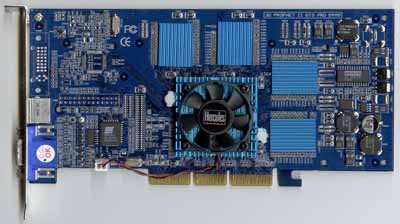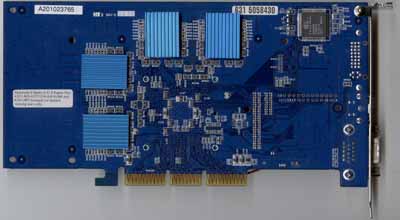
Original Link: https://www.anandtech.com/show/678
Introduction
Ever since NVIDIA caught the industry's attention with the release of their TNT graphics processor over two years ago, new NVIDIA products have been met with quite some anticipation. Many of us who follow the video card industry will vividly remember the release of NVIDIA's last few products: the TNT2, the GeForce 256, and most recently the GeForce2.
Along with each processor announcement came a barrage of reviews and press. Weeks after an announcement would pass before NVIDIA related news stopped appearing. For months to come, the previously announced product would be pushed to its limits, scrutinized, and rated against the competition. In general, every NVIDIA product release has been met with quite a hoopla.
Despite all the controversy that normally accompanies an NVIDIA product announcement, one NVIDIA product managed to slip between the cracks. Although it is true that three months ago NVIDIA finally was able to announce a new generation of the GeForce2 line, the GeForce2 Ultra, another GeForce2 product seemingly just appeared. There was no press release, no large product announcement, no hoopla; just a new product on NVIDIA's ever growing list.
This mysterious product is the newly discovered GeForce2 Pro GPU, a processor which is still the cause of much confusion. Since the product was not hyped up as all other NVIDIA products have been, many users are wondering what the deal is with the GeForce2 Pro. Let's take a look at NVIDIA's latest offering and see what is behind this new incarnation of the GeForce2 core.
The Chip
Since the GeForce2 Pro is based on the same core as the GeForce2 GTS, it shares many things in common to the GeForce2 GTS. In fact, the GPU side of the GeForce2 Pro is identical to the GPU of GeForce2 GTS. Let's refresh our memory on what this entails.
Many of us will recall the April 2000 introduction of the GeForce2 GTS GPU. Promising unparalleled speed, the GeForce2 GTS core proved to be essentially a 0.18 micron version of the original GeForce 256. In fact, the only item which changed from the GeForce 256 is the rendering pipelines. The GeForce2 GTS still features 4 rendering pipelines, just like its older brother, but unlike the GeForce 256, the GeForce2 GTS core is able to process two textures per pipeline in a single clock. This is a rise of one texture per pipeline when compared to the GeForce 256's single texture unit per pipeline. On the number side, this translates to rendering power equal to twice that of the GeForce 256 at the same clock speed.
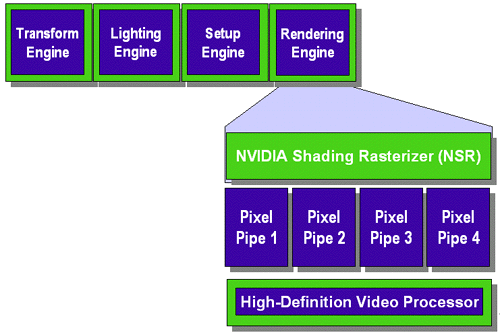
As we mentioned previously, the GeForce2 GTS core is manufactured on a 0.18 micron process, which allowed it to carry a 200MHz core clock. However, as we realized with the GeForce 256 as well as the GeForce2 GTS, increasing the core clock proved to be relatively ineffective in the fight for greater performance. The reason being that before the card is given the opportunity to hit its maximum fill rate, which is determined by the GPU's core clock speed, it is limited by the amount of memory bandwidth that the GPU is provided with.
The reason we mentioned this is because NVIDIA is aware of this fact as well. In order to differentiate the GeForce2 Ultra from the GeForce2 GTS, NVIDIA hand picked those chips which could hit the 250MHz operating frequency of the Ultra. This 25% increase in core clock speed didn't buy the Ultra all that much performance, but it was necessary to justify the $500 price tag.
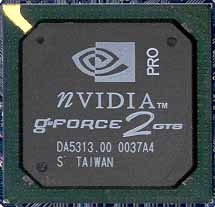 With
the GeForce2 Pro, being positioned as solution more powerful than a GeForce2
GTS but less powerful and also cheaper than a GeForce2 Ultra, the core clock
remains the same as the GTS, stuck at 200MHz. With a 200MHz clock the GeForce2
Pro boasts the same 1.6 Gigatexel/s fill rate as the GeForce2 GTS, but in most
situations the chip will never have the opportunity to reach that fill rate
because of limited memory bandwidth.
With
the GeForce2 Pro, being positioned as solution more powerful than a GeForce2
GTS but less powerful and also cheaper than a GeForce2 Ultra, the core clock
remains the same as the GTS, stuck at 200MHz. With a 200MHz clock the GeForce2
Pro boasts the same 1.6 Gigatexel/s fill rate as the GeForce2 GTS, but in most
situations the chip will never have the opportunity to reach that fill rate
because of limited memory bandwidth.
This brings us to the only "upgraded" aspect of the GeForce2 Pro design over the GTS, that is the 200MHz DDR memory clock (effectively 400MHz). At 200MHz DDR, the GeForce2 Pro features a 20% higher memory clock than the GTS (166MHz DDR) resulting in a theoretical maximum of 6.4GB/s of bandwidth to and from the on-board frame buffer. For the sake of comparison, a regularly clocked GeForce2 GTS features 5.3GB/s of available bandwidth while the Ultra can boast an impressive 7.36GB/s.
By featuring the same core that is on GeForce2 GTS boards NVIDIA doesn't have to worry about having to hand pick low-yield parts that work properly at higher clock speeds, resulting in a cost per chip identical to that of a GeForce2 GTS GPU since they are the same part. This can't be said for the Ultra which, by definition, uses a specially picked chip that will end up costing more for a manufacturer to purchase from NVIDIA.
The issue of cost rears its head yet again in the Pro vs Ultra comparison when you take a look at the decision to outfit Pro based cards with memory capable of hitting 200MHz rather than the 230MHz chips used on Ultra boards. In all actuality however, Ultra boards have to use 4ns (500MHz) DDR SDRAM because of currently low-yields on the parts in spite of the fact that they are only clocked at 460MHz. This ends up inflating the cost of Ultra cards quite a bit as 4ns DDR SDRAM isn't that easy to come by, however it is necessary to allow the Ultra to offer a significant performance advantage over the regular GTS.
The Pro attempts to maintain a balance between these two extremes by requiring 4.5/5ns DDR SDRAM chips (4.5ns = 222MHz DDR while 5ns = 200MHz DDR). This helps reduce the cost of implementing a GeForce2 Pro design because of the higher yield and more readily available memory requirements.
The picture that is being painted here seems to be much more attractive than that of a GeForce2 Ultra, simply because you get characteristics similar to an Ultra but at decreased price. While you can find GeForce2 Ultra cards in the $400 - $500 price range, with the average price falling closer to $465, GeForce2 Pro based solutions can be had for approximately $100 cheaper. The cheapest Ultra we've seen being $420, while we've seen GeForce2 Pro's go for less than $310.
At that price point, the GeForce2 Pro is much more reasonable than the Ultra, so what's the catch? It turns out that the reason NVIDIA didn't make that big of a deal out of the launch of the GeForce2 Pro is because it was originally intended to be an OEM-only solution.
In spite of this, one manufacturer sought to bring it to the retail markets and take advantage of the GeForce2 Pro's unique price/performance combination.
Enter the Hercules/Guillemot 3D Prophet II GTS Pro based on the GeForce2 Pro GPU...
The Card
The 3D Prophet II GTS Pro is manufactured by Guillemot under the Hercules name which they bought a while ago from a dying Hercules company. The board continues in this recent tradition from Guillemot by demonstrating a blue PCB along with blue heatsinks that help to set it apart from the competition aesthetically, however that doesn't buy it too much in terms of added value.
Other than the blue motif you'll also notice that the card is approximately 1" longer than the reference GeForce2 Ultra design from NVIDIA, however a great deal of space is wasted on the PCB. There are silkscreens present on the PCB that outline the missing external TMDS transmitter and its accompanying DVI port with no actual component circuitry present. The true motivation behind the 3D Prophet II GTS Pro's extra large size is the integration of a Conexant (Brooktree) BT869KRF video-out decoder chip on the card. Although the PCB's silkscreen does include an outline for the pin headers used to control the reference designed daughter board, Guillemot has chosen not to include the header but rather to incorporate the video-out chip on the back of the PCB.
 In
order to make room for the BT869 chip and the traces that run to the output
connector, Guillemot had to move the power components normally present in the
upper left hand corner of the card. It is for this reason that the 3D Prophet
II GTS Pro is longer than the GeForce2 Ultra reference design (the same one
used by the GeForce2 Pro). As you can see, the BT869 chip forces the power components
to the back of the card, extending it a full inch. Although we normally cite
larger PCB space as a waste of money, in the case of the 3D Prophet II GTS Pro,
Guillemot most likely saves quite a bit of money. This is because it is no longer
necessary to produce a separate PCB in order to allow video-output. In fact,
we have seen Guillemot use this design before in later model 3D Prophet II GTS
boards.
In
order to make room for the BT869 chip and the traces that run to the output
connector, Guillemot had to move the power components normally present in the
upper left hand corner of the card. It is for this reason that the 3D Prophet
II GTS Pro is longer than the GeForce2 Ultra reference design (the same one
used by the GeForce2 Pro). As you can see, the BT869 chip forces the power components
to the back of the card, extending it a full inch. Although we normally cite
larger PCB space as a waste of money, in the case of the 3D Prophet II GTS Pro,
Guillemot most likely saves quite a bit of money. This is because it is no longer
necessary to produce a separate PCB in order to allow video-output. In fact,
we have seen Guillemot use this design before in later model 3D Prophet II GTS
boards.
Going along with the blue motif, Guillemot includes blue memory heatsinks (RAMsinks) on each of the eight memory chips. We are not sure if the reference design calls for these heatsinks (Guillemot has used them in the past where they were not required) but we suspect that the memory heatsinks are called for by NVIDIA. It is here that we see another way that the GeForce2 Pro chip follows in the foot steps of the faster GeForce2 Ultra part. Both cards seem to require memory heatsinks in order to maintain proper operation of the memory. It seems that current memory technology can not run faster than around 166 MHz DDR while maintaining stability without some form of cooling. In the case of the GeForce2 Pro, as well as the GeForce2 Ultra, this cooling comes in the form of memory heatsinks, in this case blue ones.
Taking off the memory heatsinks, which are attached to the chips with thermal tape, reveals that the 3D Prophet II GTS Pro is powered by 5.0ns (200 MHz) EliteMT memory. The board contains a total of eight SDRAM chips with four, 8MB chips on each side of the PCB for a total of 64MB of memory.
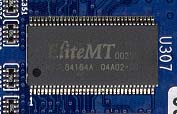
Finally on the card side, the 3D Prophet II GTS Pro makes use of a standard heatsink and fan combination on the GeForce2 Pro core. Since the GeForce2 Pro core actually operates at the same temperature as the GeForce2 GTS, there is no reason for a heatsink or fan upgrade on Pro based cards. In fact, the 3D Prophet II GTS Pro utilizes the same heatsink and fan combination found on the 3D Prophet II GeForce2 GTS. Unfortunately, Guillemot chose to attach the heatsink and fan to the GeForce2 Pro core with only the use of side clips and a non-adhesive thermal pad. This method of heatsink attachment does not result in optimum heat transfer from the core to the heatsink; properly applied thermal grease would have done the job much better.
The Drivers
As many NVIDIA owners may have noticed, the GeForce2 Pro is supported in the latest Detonator3 driver release from NVIDIA. As a result of this, the GeForce2 Pro driver remain the same drivers we investigated seven months ago. Build numbers have increased but functionality and speed have remained the same for the most part. A full review of the GeForce2 Pro's driver set, the Detonator3 drivers from NVIDIA, can be found in our Detonator3 review.
The Test
|
Windows 98 SE Test System |
||||||
|
Hardware |
||||||
|
CPU(s) |
AMD Athlon Thunderbird 1.1GHz |
|||||
| Motherboard(s) | ASUS A7V | |||||
| Memory |
128MB
PC133 Corsair SDRAM
|
|||||
| Hard Drive |
IBM Deskstar DPTA-372050 20.5GB 7200 RPM Ultra ATA 66 |
|||||
| CDROM |
Phillips 48X |
|||||
| Video Card(s) |
3dfx
Voodoo5 5500 AGP 64MB |
|||||
| Ethernet |
Linksys LNE100TX 100Mbit PCI Ethernet Adapter |
|||||
|
Software |
||||||
|
Operating System |
Windows
98 SE |
|||||
| Video Drivers |
|
|||||
|
Benchmarking Applications |
||||||
| Gaming |
idSoftware
Quake III Arena demo001.dm3 |
|||||
Quake III Arena Performance

As a result of CPU limitations in all three GeForce2 series cards, all of the cards perform the same at 640x480x32. This is because at 640x480x32, the video card is not acting as the bottleneck in the system rather the CPU is, a fact that creates similar scores in all of the cards.

At 1024x768x32 the cards begin to distance themselves. We can see the GeForce2 GTS scoring in at 100 FPS, with the new GeForce2 Pro clocking in at 115 FPS, an increase of 15%. The Pro does not fall too far behind the GeForce2 Ultra, as the cards only differ by 7 FPS in Quake III Arena at 1024x768x32. For about $100 less, the difference is marginal.

At 1600x1200x32, we can see how the GeForce2 Pro fits the gap between the GeForce2 GTS and the GeForce2 Ultra perfectly. The Pro rings in at 8 FPS higher than the GeForce2 GTS and 10 FPS slower than the GeForce2 Ultra. At 47 FPS, the GeForce2 Pro provides playable gameplay at 1600x1200x32, making it the lowest priced card to offer this performance.
MDK2 Performance

Similar to what we saw in Quake III Arena at 640x480x32, the driver engine of the GeForce2 series cards are up to par, meaning that only the CPU remains as the limiting factor, for the most part. As you can clearly see in the above graphs, both of NVIDIA's "fastest" offerings actually perform below their lower costing counterparts, the GeForce2 GTS and the GeForce DDR. This performance difference is most likely a result of the less efficient SDRAM memory used in both the GeForce2 Pro and the GeForce2 Ultra. Since both the GeForce2 GTS as well as the GeForce 256 DDR use SGRAM chips, it is expected that we see some sort of performance difference between the two at very low resolutions. This does not last long, however.

At 1024x768x32, we find that the GeForce2 Pro continues to fill the gap between the GeForce2 GTS and the GeForce2 Ultra. Running at 131 FPS, the GeForce2 Pro performs about 16% faster than the GeForce2 GTS and about 5% slower than the GeForce2 Ultra, placing the card closer to Ultra performance in MDK2 at 1024x768x32.

The performance of the GeForce2 Pro at 1600x1200x32 models the results we saw at 1024x768x32. Once again, the GeForce2 Pro performs 8 FPS faster than the GeForce and 10 FPS slower than the GeForce2 Ultra, providing us with the same performance difference we saw in Quake III Arena under this resolution.
Unreal Tournament Performance

The minimum frame rate numbers at 640x480x32 show that there is not much of a performance difference in the cards when it comes to the minimum frame rates they will render at when at this resolution.

The average frame rate numbers at 640x480x32 show all cards performing nearly identical. On the top of the list is the Voodoo5 5500, a card which has always been favored by Unreal Tournament in lower resolution. The GeForce2 Pro clocks in at 94 FPS average.

At 1024x768x32 we see that the GeForce2 Pro ties the GeForce2 Ultra as the card producing the highest minimum frame rate. The Radeon cards come in second, with the Voodoo5 5500 falling to the bottom of the list.
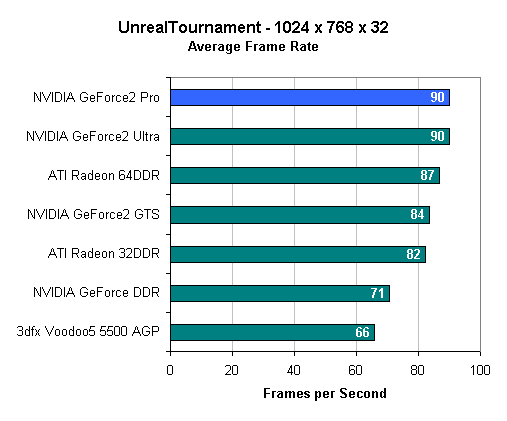
Once again we see the GeForce2 Pro tying the GeForce2 Ultra in average frame rate, meaning that these cards perform the "fastest."

At 1600x1200x16, we can really see where the extra memory bandwidth goes in Unreal Tournament. At this resolution, the GeForce2 Pro and the GeForce2 Ultra only differ by 4 FPS when it comes to minimum frame rate. Even if you hit this frame rate in game play, there should be no loss of smoothness.
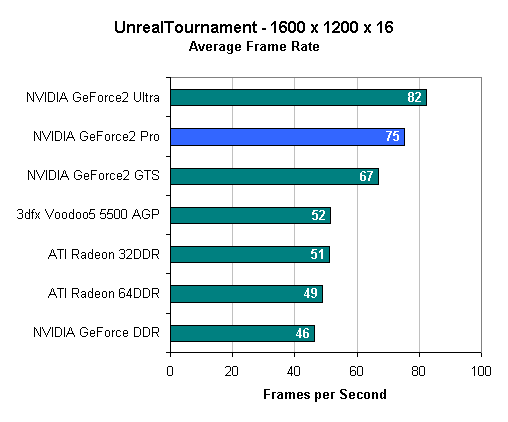
The average frame rate numbers show nearly the same performance differences we saw in the minimum frame rate numbers. Once again, the GeForce2 Pro falls behind the GeForce2 Ultra by 7 FPS but manages to race ahead of the GeForce2 GTS by 8 FPS. Do you see a trend here, as the GeForce2 Pro continues to fit right between the GeForce2 GTS and the GeForce2 Ultra?
16-bit vs 32-bit Performance
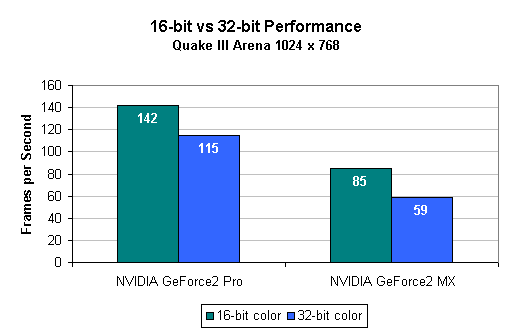
At 1024x768, the 16-bit performance gained by the GeForce2 Pro is very similar to the performance gained by the GeForce2 MX when going from 32-bit color to 16-bit color. In the case of the GeForce2 Pro, one can expect a 23% performance increase when going from 32-bit to 16-bit color at 1024x768. This is less than the 44% increase in performance that the GeForce2 MX experiences, but the raw speed of the GeForce2 Pro makes up for its sub par 16-bit vs 32-bit performance.
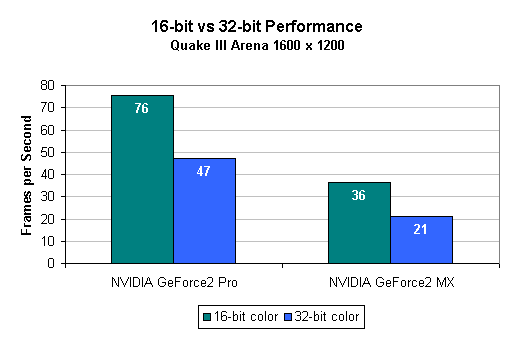
At 1600x1200 both the GeForce2 Pro and the GeForce2 MX scale similarly when decreasing color depth. In the case of the GeForce2 Pro, one can expect a 61% performance increase while in the case of the GeForce2 MX one can expect a 71% performance increase. These large performance increases could become very important in the future as they could mean the difference between decreasing color depth or having to switch revolutions.
CPU Scaling Performance
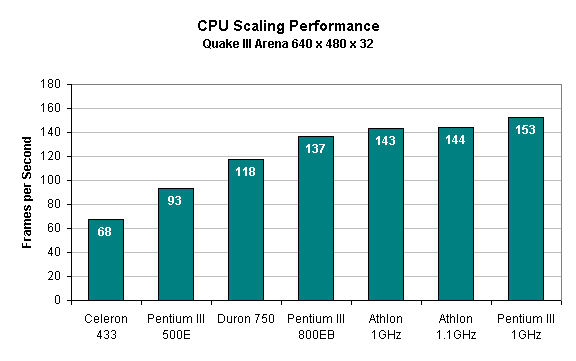
CPU scaling gives us an idea of how a card will perform in a system besides the 1.1 GHz tested in this review. As the above graph shows, the GeForce2 Pro seems to like higher end processors, such as the Pentium III 800 EB and beyond. Below this mark, performance of the GeForce2 Pro seems to be very lackluster compared to what it could be getting. One question remained, however: was the GeForce2 Pro the item that was performing differently on the various systems or was it simply reflecting the processor speed since the CPU was acting as the bottleneck?
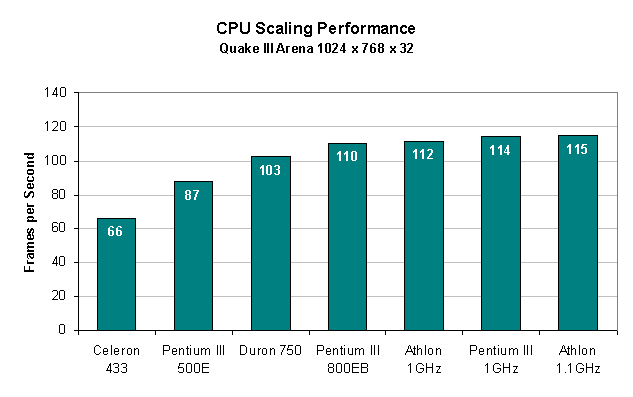
Normally we do not test CPU scaling at 1024x768x32, however the GeForce2 Pro proved to be a special case. We needed to know if in fact the GeForce2 Pro was acting as the limiting factor of if the CPU was providing a system bottleneck. As the above results show, testing at 1024x768x32 provide us with the same results we saw at 640x480x32. We still see that the GeForce2 Pro needs a faster processor, such as the Pentium III 800EB, to provide maximum performance. Therefore, the GeForce2 Pro is acting as the as the limiting factor, not the CPU.
Windows 2000 Driver Performance
As we noted in the driver section, the GeForce2 Pro utilizes the same driver set as all other NVIDIA products, the Detonator3 driver set. Therefore, we can conclude that the Windows 2000 performance of the GeForce2 Pro will be identical to the performance while under Windows 98. For more information, please see the GeForce2 MX Windows 2000 Performance section of our Budget Video Card Comparison for November 2000.
Overclocking
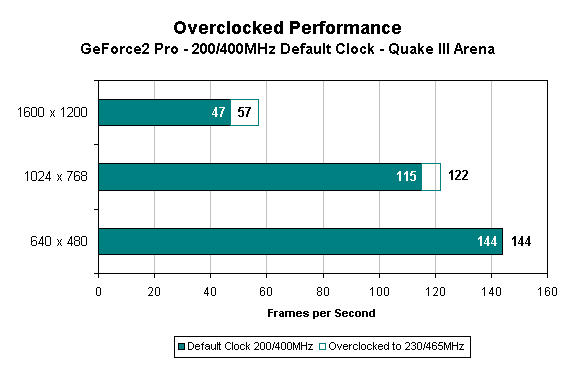
The 3D Prophet II GTS Pro did not provide us with the ideal overclocking platform. Although memory heatsinks are standard, the lack of thermal compound between the core and the heatsink and fan combination means we may have lost some overclocking ability here.
Regardless of any inadequate cooling methods, the GeForce2 Pro was very willing and able to overclock. Reaching a maximum speed of 230 MHz in the core and 465 MHz in the memory, the GeForce2 Pro actually surpassed GeForce2 Ultra speeds when overclocked. The performance increase as a result of this overclocking is nothing to be taken lightly: although the CPU bottleneck at 640x480x32 results in no performance difference between the standard card and the overclocked card, at 1024x768x32 the overclocked GeForce2 Pro gains a 6% speed boost and at 1600x1200x32 is able to boast a 21% performance increase. Running at 57 FPS when overclocked, the GeForce2 Pro was actually able to tie the GeForce2 Ultra.
We suspect that many GeForce2 Pro cards will be able to reach similar speeds as a result of the 200 MHz memory used on the card. A boost from 400 MHz to 465 MHz requires an overclock of just 32 MHz of SDR performance, something we are used to getting out of memory chips.
On the core side, it is not a surprise that that GeForce2 Pro overclocked to about the average we saw in GeForce2 GTS chips. Although we were able to get a good number of GeForce2 GTS cores higher than the 230 MHz that the GeForce2 Pro hit, the limitation is most likely not in the chip itself but rather in the poor cooling method used by the 3D Prophet II GTS Pro. It is unfortunate that any further MHz gain from the GPU will most likely not result in any increase in performance as a result of the memory bandwidth limitations that are present even at a 465 MHz memory bus.
Conclusion
Weighing in with a price of around $330, the GeForce2 Pro chip is targeted to fit the void recently created with the falling price of the GeForce2 GTS and the high price of the relatively new GeForce2 Ultra. As we have seen in the past, most recently with the GeForce2 Ultra, many times increased performance does not justify a high price. Does the GeForce2 Pro share this trait with its faster (albeit more expensive) brother?
Examining only performance, the answer seems to be yes. With a price running about $100 to $150 more than a 32MB GeForce2 GTS and only about $40 more than a 64MB GeForce2 GTS, the GeForce2 Pro picks up what the GeForce2 GTS left behind a few months ago. Picking up the higher end of the video card market while still remaining accessible to many in the video card market, the GeForce2 Pro is not a budget card like the GeForce2 MX, nor is it excessively expensive like the GeForce2 Ultra. For many high end gamers, the GeForce2 Pro will not only fit the bill but also provide performance very similar to a GeForce2 Ultra. In fact, as we saw in the overclocking section, our sample GeForce2 Pro card, the Guillemot 3D Prophet II GTS Pro was able to reach Ultra speed when overclocked.
The GeForce2 Pro also provides more longevity than both the 32MB and 64MB versions of GeForce2 GTS. Right now the increase in performance equates to being able to play games at higher resolutions, but in the year to come it may mean the difference between being able to play a cutting-edge game or not. For many, this peace of mind will surely justify the increase in price.
The problem is that we can not rely only on performance numbers for a recommendation of a high-end card. As was the case in the GeForce2 Ultra, we must also take into account what is coming up in the GeForce2 Pro's price range. The GeForce2 Pro is entering the market late in the GeForce2 line. With rumors of NVIDIA's next chip, the NV20, arriving as early as the beginning of next year and providing performance significantly grater than that of the GeForce2 Ultra, one can not help but wonder if now is the best time to spend $300 or more on a video card. It looks like that $300 will buy you much more in just a few short months here, so for many the best option is to stick with the current card for just a bit longer and wait to spend that holiday money until early next year.
If the GeForce2 Pro was launched along side the GeForce2 Ultra, a full 2 months ago, our recommendation would have likely been different. The extra time and lack of information regarding the NV20 in August would have likely led us to suggest the GeForce2 Pro as the high-end gamer's card of choice. However, the past two months provided us with enough information to withhold or recommendation of the GeForce2 Pro. Sure, the card is powerful and priced within reasonable bounds, but the OEM only designs (with exception to the Guillemot card we examined here) and the fact that the NV20 is on the way means that most die hard gamers would be better off waiting for a more powerful card at the same price.

